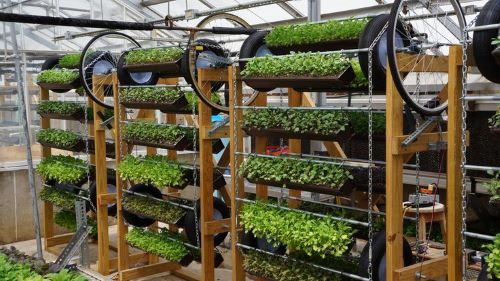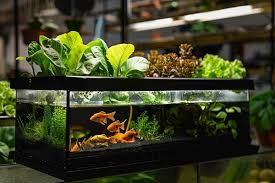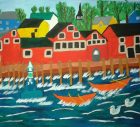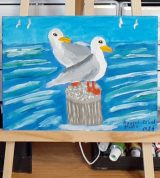Aquaponic Fish & More…
Aquaponics Gardening Basics: Raft System Vs Ebb & Flow

So many folks are actually changing their lifestyles. Back to the Land. Organic gardening. Living off the Grid. Getting free from the Machine.
Some are returning to a simpler way of life. One based on traditional values and workways.
Others are genuinely afraid of the changing world: whether a looming crisis presenting itself as the dire results of Climate Change. Like a super hurricane, unending blizzard, massive wildfire, or cataclysmic flood. Or unnatural disasters brought about by financial collapse, civic breakdown, devastating bioterrorist-released pandemic or modern warfare carried to our own doorsteps.
No matter what, the most important factor in any breakdown is Water. And the second is Food.
Hence the increasing interest in hydroponic farming. In a way, it combines the two. More important, it increases your yield of fresh, organic food TEN TIMES! And gives you a wide range of natural herbal medications…
Certainly, self sufficiency is becoming an essential choice for many of us. A clear choice of standing our ground against destructive forces and re-creating a healthy and safe world for our families. Even if that world is only our immediate home area.
Here, from long-time Organic Gardener Ethan Mills, is a Guest Blog on this very subject, a Crash Course on getting into Aquaponic Farming…
“Aquaponic Gardening Basics” A Guest Blog by Ethan Mills
>> What is Aquaponics? And Why is it Changing Everything?
What if I said to you that you could have fresh organic vegetables year round in the convenience of your own home?
And if I told you that you can grow food up to TEN TIMES the volume of any other natural, organic farming method?
Well, this is possible by using an aquarium, with ornamental fish and growing beds for crops of your choice. A home system can serve as a beautiful show piece or a food production system, depending on the size.
Many backyard aquaponic gardeners are setting up systems to grow hundreds of pounds of fish and an endless supply of herbs and vegetables a family needs.
These Backyarders quickly produce more fresh food than they can eat. At which time they can either preserve those vegetables, fish and herbs for “a rainy day” or sell it for income and profit.
What is Aquaponics?
The ancient Aztecs did it, among other cultures. It’s simply using fish waste from the fish in your tank or outdoor pool to feed the plants you wish to grow. The nitrogen cycle takes care of the magic by filtering the dirty water in the grow bed before it returns to the fish.
This allows for the best conditions for growth of your plants and fish that you are raising.
An aquaponic system does all the hard work for you, so you don’t have to filter the fish waste and you won’t have to worry about feeding your plants, which makes it easy aquaponics.
Hydroponics is a method of growing crops without using soil. You have to use nutrition solutions to feed the crops, which are elements added to the watering system and delivered to the roots. NO CHEMICAL FERTILIZERS! NO WEEDS! NO TILLING!
With this system, the plants need to be secured with a growing medium such as, lava rock.
The growing mediums not only secure the plants, it provides moisture, and a place for bacteria to thrive! If a growing medium was not used then sprayers would be used and this would be considered an aeroponics system.
The other part of aquaponics is aquaculture: the water is provided all the elements for the plants to grow from the fish waste. Without having crops, this naturally filtration system would not function properly, which would lead to the death of your fish. You need to balance of fish and plants for aquaponics to work properly.
There are great benefits to aquaponic gardening, especially because of the efficiency and space saving methods of fish farming, growing crops of your choice.
It allows hydroponic growers to cut cost of buying fertilizers, and helps fish farmers with the filtration of the fish waste. AND – – NO PESTICIDES.
Commercial aquaponics system operators are limited, however, because (like solar panels) it works best in family-sized holdings. And among them, there’s a strong level of interest in this organic method of food production. With little maintenance of less than 20 minutes a day, you can have fresh fish and vegetables year-round.
>> Aquaponic Raft System vs. Ebb and Flow
There are many different types of aquaponic systems. The two most common are The Raft System and Ebb & Flow.
Parts that are the same are the fish tank and a plant bed. Differences include filtration techniques, plumbing, the type of plant bed, growing medium, and the frequency of water and aeration. Some of the more popular aquaponic methods emerging in the industry are methods based on a hydroponic system design, and raising fish for filtration.
1. The Aquaponic Raft Method
Let us start with The Raft System Method, also known as deep channel, float and deep flow. The idea is for your crops to be grown on top of the water in the Styrofoam boards. Rafts are usually in a tank separate from the fish tank. The water in the raft grow bed is highly nutritious because of the fish waste, plants will eat it up!
Our nutrient-rich water flows continuously from the fish tank, through filtration components, through the raft tank where the plants are grown and then back to the fish tank. The beneficial bacteria that make this nitrogen cycle work, live in the raft tank and throughout the system.
The water in the raft tank provides a buffer for the fish, reducing stress and potential water quality problems, which is one of the greatest benefits of the raft system. Plus, this method has been improved for over 25 years. The raft system is a well developed method that allows for high plant production per square foot. Commercial raft systems can cover large areas, best utilizing the floor space in a greenhouse.
Vegetable seedlings are best placed on one end of the raft tank. The rafts are pushed forward on the surface of the water over time and then the mature plants are harvested at the other end of the raft. Once a raft is harvested, it can be replanted with seedlings and set into place on the opposite end. This optimizes floor space, which is especially important in a commercial greenhouse setting.
2. The EBB (Flood and Drain) Method
Hydroponic Ebb and Flow uses media filled beds that are periodically flooded with water from the fish tank. The water is drained after the water level rises above the bell siphon and flows back to the fish tank. All waste, including the solids, is broken down within the plant bed.
Sometimes worms are added to the gravel-filled plant bed to enhance the break-down of the waste. This method uses the fewest components and no additional filtration, making it simple to operate and naming it one of the best aquaponic system methods. Plant production is less than the aquaponic method described above. The media-filled bed is often used for hobby applications where maximizing production is not a goal.
>> Aquaponic Plants You Can Grow In An Aquaponics System
The aquaponic plants are where it’s at! That’s the great benefit of aquaponics, enjoying the vegetables and fruits when they are ready to be eaten. While the crops are growing, the nitrogen cycle occurs because of the bacteria in the root systems. This is where the water is filtered and cleaned before it returns back to the fish.
Without plants the system cannot function properly.
Research has shown that plants were proven to be an effective means of water purification for aquaculture. Lettuce, chives and other leafy crops were first considered for aquaponics but, more recently, commercial growers and researchers have had great success with tomatoes, cucumbers, peppers, melons, flowers and many other crops.
Growing plants in your backyard in the soil takes up valuable space and is labor intensive. Dirt farming is kind of a knee jerk response. You see the plants wilting and add water, plants yellowing and add nitrogen or compost. Aquaponics takes care of this automatically, without much thought except to insure the flow of water.
If the electricity quits or a pump fails the plants will survive several days up to two weeks depending on the temperature, but of course the fish will die sooner.
Even plants needing large amounts of nitrogen, like tomatoes, can exist side by side with plants that require little, like lettuce. The nutrient rich water reaches all plants and because it only passes through, only what is needed is used.
Even with good plant coverage there are a lot of nitrates flowing out the drains back to the fish tank, enough in fact to power up another group of grow beds. This is not a concern unless the water is cloudy in the fish tank. We have found that 6-8 grow beds per 400 gallon tank is a good operating number.

Aquaponic Plants
Tomatoes, Peppers, Spinach, Onions, Cucumbers, Pak Chov, Squash, Lettuce, Basil, Begonias, Impatiens Peas Beets, Swiss Chard, Black Seeded Simpson, Water Cress, Watermelon, Chives, Cabbage, Redina, Lettuce. Endive, Amaranth. Celery, Tatsoi, Collard, Garlic, Chives, Zucchini, Okra, Cilantro. Most common household plants: Recao, Cantaloupe. Mustard, Mints, Arugula, Beans, Taro, Spinach, Parsley, Kale, Dill Rice, New Tomatoes.
If you want have the best tasting vegetables, make sure you purchase organic seeds, so that you know exactly that your crops will be 100% organic. This way you will enjoy the real taste of freshly harvested vegetables in the comfort of your home. What can be better than that?!
>> Aquaponic Fish: Fish for Aquaponics
You need fish to have a properly functioning aquaponics system. The reason why fish are required to complete this aquaponics cycle is within the fish waste. Those tomatoes, peppers, lettuce and other plants you are growing require nitrogen, which is produced by the fish waste.
All aquaponics systems must have the nitrates filtered from the water or the aquaponics fish will die. The growing containers act as this filter because the plants roots take care of everything there. Plants and fish must be present in this system for The Aquaponic Nitrogen Cycle to take place.
Just about any freshwater fish can be used in the system although the operating temperature prohibits rearing of species such as trout. If you don’t care about either eating or selling the fish we recommend using half of the fish as goldfish and the other half as common carp.
One fish per 1.5 gallon water is the maximum a system can handle especially as the fish grow larger. Goldfish and common carp can be bought cheaply at bait stores in most parts of the country.
Suitable Fish For Aquaponics are:
Walleye, Tilapia, Yellow Perch, Lake Perch
Channel Catfish, Bluegill, Hybrid Striped Bass, Northern
Crayfish, Largemouth Bass, Smallmouth Bass, All Carp, Goldfish
Sunfish, Bream, Crappie, Pacu, Koi, and Freshwater Ornamentals.
Aquaponics Fish Food:
Your fish need food to produce the waste which helps this amazing cycle happen. The pellets or organic fish foods can cost over time, however, there are a few methods for creating fish food. One of the aquaponic secrets is that you can raise fish food that doubles itself every 24 hours under correct conditions. This is a great money saver and fits in with doing less work is more.
Duckweed can easily be made in large barrel halves. The water temperature needs to be 60-70 degrees F. and rich in nutrients. These nutrients can come from manure tea made from donkey dung and other sources. Fish eat duckweed slower than commercial feeds, because they are rich with protein and other elements.
The cool thing about duckweed is that it just floats around and too much does not constitute nitrate buildup like with uneaten commercial pellets.
Eventually it will be eaten and, meanwhile, it is making more duckweed. In nature, duckweed can be found floating in calm waters, either fresh or brackish.
Virtually all the plant is metabolically active and totally useful as a feed or food. Duckweed has high concentrations of essential amino acids, lysine, methionine, carotene, xanthophylls and trace minerals making it one of the best animal feeds available for either fish or animals like rabbits, sheep, goats or cattle. It can be fed wet or dried without significant loss of nutrients.
Nitrogen Ammonium is the preferred form of food for duckweed. This is fortunate for us as the aquaponic system produces an abundance of this material. Therefore duck-weed does great in such systems except for trace minerals Duckweed growing in half barrel which because of the soil-less nature in aquaponics, are sadly lacking. This factor can be solved as it exists for not only the duckweed but both the plants and fish as well.
A homemade hydroponic system allows for family activity which can promote healthy eating and helps stretch the food budget.
This family activity provides a great way to teach children how to grow food and care for living things.
Starting off with a small aquaponics setup may be the easiest to grow vegetables than other systems because of the minimal amount of work you have to do once it is up and running…
So you have been thinking “I want try Hydroponics. But very small at first.”
Check out your local gardening and hardware stores. There are a number of easy to assemble Home Garden Units you can put in any corner of your house or shed!
Thanks, Ethan, for this essential Guest Blog!
“Live Free, Mon Ami!” – Brian Alan Burhoe
About the Guest Author: “My name is Ethan Mills and I’ve been an avid organic gardener for as long as I can remember. In that time, I’ve gained a huge amount of knowledge about organic gardening and aquaponic systems. Yes, I’m an aquaponics enthusiast! It’s my goal to see that your garden is properly cared for, so I’d like to share my knowledge with you.” As of this posting, Ethan can be found on Facebook — just login to FB and search for his “Aquaponic Secrets.”
See Us on Our CELL PHONE FRIENDLY Format: BrianAlanBurhoe.com.
Aquaponics: Aquaponic Farm Raft System Vs Ebb and Flow
Keywords: aquaponic farm, aquaponic fish, aquaponic garden, aquaponics, aquaponic system, ebb and flow, farming, greenhouse. Hydroponic garden, hydroponic grow, hydroponics, natural herbal medications, nutrients and talapia.












